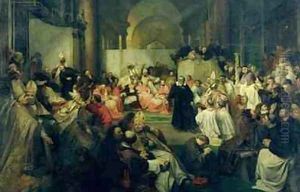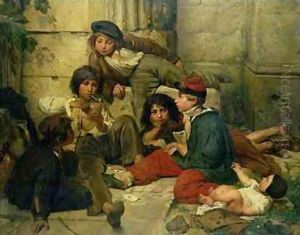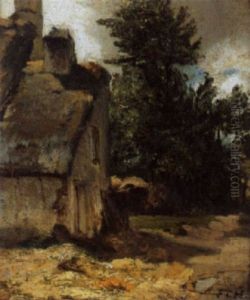Friedrich Karl Hausmann Paintings
Friedrich Karl Hausmann was a 19th-century German painter, primarily known for his portraits and historical scenes. Born on February 14, 1825, in Hanover, Germany, Hausmann demonstrated a keen interest in the arts from an early age. His father, Ludwig Hausmann, was also a painter, which provided the young Friedrich with a nurturing environment for developing his artistic skills.
He began his formal education in art at the Royal School of Painting in Hanover. In 1842, Hausmann moved to Düsseldorf, where he studied at the Düsseldorf Academy, one of the most prestigious art schools in Germany at the time. There, he was influenced by the Düsseldorf school of painting, which was known for its meticulous detail, use of color, and emphasis on historical and landscape painting.
After completing his studies, Hausmann traveled extensively throughout Europe, including Italy and France, where he was exposed to various artistic styles and techniques. These experiences enriched his painting style, which combined the realism and attention to detail of the Düsseldorf school with the romantic influences of his travels.
Throughout his career, Hausmann produced a significant body of work, including portraits of notable individuals of his time, as well as scenes depicting historical and mythological events. His works were characterized by their clarity, realistic portrayal of subjects, and careful attention to lighting and composition.
Hausmann served as a professor at the Royal School of Painting in Hanover, where he had once been a student, and contributed to the development of the next generation of German artists. His influence extended beyond his own works, as he played a role in shaping the artistic landscape of the period.
Friedrich Karl Hausmann passed away on December 10, 1886, in Hanover. His legacy is preserved through his paintings, which can be found in various museums and collections in Germany and across Europe. Despite not being widely known internationally, Hausmann's contributions to German art in the 19th century remain significant, particularly in the areas of portraiture and historical painting.


